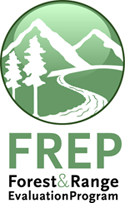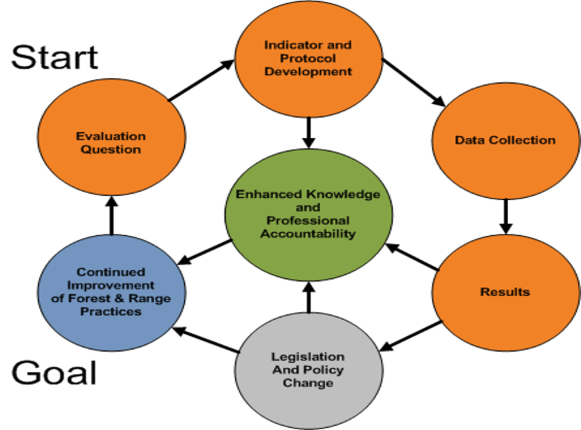Lesson 1- Introduction to FREP & Wetland Assessment

This lesson explains why we conduct routine riparian effectiveness evaluations in the context of FREP. If you have already completed the riparian evaluation training for streams, you can go directly to Lesson #2. Evaluate your learning by completing the self-check exercises at the end of every lesson. They don’t take long and will reiterate concepts that you have worked through.
Learning Objectives
Lesson 1 covers basic background information on FREP. By working through this module you will:
- Understand how the FREP program is structured.
- Understand why FREP monitoring is undertaken each year.
- Review the reference materials that will assist you in field sampling
What is FREP
The Forest and Range Evaluation Program (FREP) is a foundational element of the Forest and Range Practices Act (FRPA). You can review the background and feature articles on the FREP website.
FREP Vision
Collect and communicate trusted and scientifically robust natural resource monitoring information to inform decision making and improve resource management outcomes.
FREP Mission
- Assess the impacts of forest and range activities on the 11 FRPA resource values to determine if on-the-ground results are achieving government’s desired outcomes for these values;
- Monitor and report on the condition of resource values, including trends and causal factors; and
- Identify opportunities for continued improvement of practices, policies and legislation, and support their implementation.
FREP is a science-based program, with monitoring protocols developed through broad expert input. To date, FREP has collected over 11,000 samples and communicated results through more than 125 publications.
FREP Objectives
FREP supports government’s key initiative and mandate objectives by:
• Providing opportunities to support Indigenous reconciliation.
• Using FREP data to inform improvements to forest practices and regulation;
• Contributing to integrated monitoring and assessment in support of modernized land-use planning; and
• Improving the accessibility and reliability of data to support defensible decision making.
Effectiveness Evaluations
Effectiveness evaluations are a foundational element of FRPA. The framework of FREP’s effectiveness evaluations aligns with professional reliance and resource stewardship. Science-based monitoring is used to inform decision-making, improve resource management outcomes, and provide evidence of the provincial government’s commitment to the objectives under FRPA. Although originally developed for government stewardship staff to monitor the effectiveness of forest and range practices, FREP evaluations can be used by any group wishing to evaluate land-use impacts.

FREP works under the legislative framework of the Forest & Range Practices Act (FRPA). FRPA contains objectives, Forest Planning & Practices Requirements (FPPR) and a C&E component. All of this is based on professional reliance and Effectiveness Evaluations that are the FREP program.

FREP Program Design
The FREP program of routine effectiveness monitoring is designed to contain several important linkages, with the final outcome being to promote continuous improvement in the stewardship of the recognized resource values. Information from field sampling is submitted to our Branch office where it can be summarized and rolled into reports such as the Multiple Resource Value Assessments (MRVA) which are shared publicly.

Wetland Management Routine Effectiveness Evaluations (WMREE)
The WMREE is supported by:
- Protocol
- Technical Guidance
- Field Checklist
- Training
- Continuous improvement
The WMREE protocol is essentially a handbook for anyone with a basic working knowledge of wetlands and/or riparian habitats, including forest and range planners, developers, and other land users. It is not essential that a person have expert knowledge on any aspect of the subject. In fact, generalists are apt to be more consistent in their assessments because they are less likely to interpret the questions and their indicators or get overly involved in detailed measurements at the expense of other indicators.
The WMREE protocol and the associated checklist guides the user to a conclusion on the relative health of a wetland and its riparian habitat in a timely fashion. Field experience indicates that, with a little practice, wetland assessments can be completed in 2-3 hours.
The checklist provides guidance for measures, counts or estimations of criteria and indicators using repeatable methodologies that support the result of a functioning condition outcome. The protocol has been field tested by people with varied backgrounds and levels of experience and found to be a consistent method of assessing the health of wetlands in BC. Perhaps more importantly, the conclusions drawn from the checklist make sense and ring true because they can usually be clearly linked to specific indicators that can be consistently observed or measured.
Why Do We Monitor?
The goal of monitoring the condition of wetlands and their adjacent riparian management areas is essentially to determine if forestry and range practices are effective in maintaining the physical and biological function of wetland ecosystems over both short and long terms.
This routine-level evaluation arose out of a need to assess the effectiveness of riparian management practices around wetlands. The assessment process is primarily used to determine functioning condition and assess whether current management practices have led to impairment in form or function of the wetland or riparian habitat. This knowledge then leads to promoting continuous improvement of forest practices and policy for working near wetlands.
LESSON 1: Self-Check Questions
True or False:
- FREP’s Effectiveness Evaluations are ONLY applicable to forestry and range management activities.
- FREP monitoring is fundamentally a C&E initiative.
Answers
- False – FREP Effectiveness Evaluations can be adopted by any group wishing to evaluate land-use impacts.
- False – FREP is all about monitoring, transparency, and continuous improvement by using random sampling to explore short and long-term trends.
